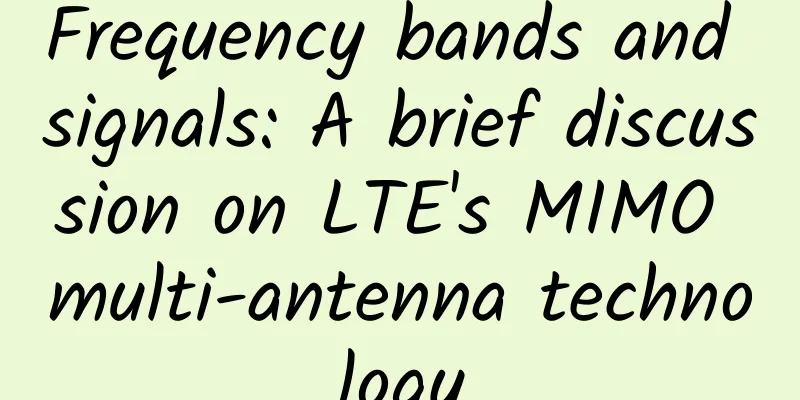Frequency bands and signals: A brief discussion on LTE's MIMO multi-antenna technology

|
We have seen it in the parameter configurations of many mobile phones. This phone supports 4*4 MIMO technology, which can greatly improve mobile phone signals and so on. However, terminal manufacturers did not explain in detail what 4*4 MIMO is, and consumers only remembered that MIMO technology can make mobile phone signals better. However, whether MIMO can improve mobile phone reception signals and how MIMO works to improve signal quality are not very clear to consumers. So what exactly is MIMO? And can it really make cell phone signals better? The answer is yes. What is MIMO? MIMO multi-antenna technology is a key physical layer technology that greatly improves LTE throughput. MIMO technology and OFDM technology are collectively known as the two most important physical layer technologies of LTE, the former being multi-antenna technology and the latter being orthogonal frequency division multiplexing technology. MIMO (Multiple-Input Multiple-Output) refers to the use of multiple transmitting antennas and receiving antennas at the transmitting end and the receiving end respectively. It differs from traditional signal processing methods in that it studies signal processing problems from both time and space aspects, thereby increasing the system data rate, reducing the bit error rate, and improving the transmission quality of wireless signals without increasing the bandwidth and transmission power. As mentioned earlier, MIMO is a multi-antenna technology and one of the physical layer technologies of LTE. Please note that it is a physical layer technology. Before talking about this, we need to mention a formula - the Shannon formula.
In the above formula, Shannon gave the formula for the limit capacity of a SISO wireless channel with a single transmitting antenna and a single receiving antenna. SISO is opposite to MIMO. MIMO is multiple-input multiple-output, while SISO is single-input single-output. B is the channel bandwidth, S/N is the signal-to-noise ratio at the receiving end (the ratio of signal to noise in an electronic device or electronic system. The signal here refers to the electronic signal from outside the device that needs to be processed by this device, and the noise refers to the irregular additional signal (or information) that does not exist in the original signal after passing through the device, and this signal does not change with the change of the original signal, and the unit is dB). From the Shannon formula, we know that increasing SNR or increasing bandwidth can increase the capacity of wireless channels. However, both the transmission power and bandwidth have certain limits. Under certain bandwidth conditions, no matter what coding and modulation methods SISO uses, the system capacity cannot exceed the limit of the Shannon formula. The widely used Turbo code and LDPC code have brought the channel capacity close to the channel capacity limit. It should be noted here that the multi-antenna technology in LTE does not break the limit defined by Shannon's formula, but is equivalent to the combination of multiple single channels. We set N to be the number of transmitting antennas and M to be the number of receiving antennas. MIMO is a multi-antenna technology, so its antenna configuration can be expressed as N*M. The existing antenna configurations include 1*2 (1 receive and 2 transmit), 2*2, 2*4, 4*4, etc. Assuming that each antenna at the transmitting end transmits independent equal power and each signal satisfies the Rayleigh distribution, based on the channel transmission characteristics of the MIMO system and the calculation method of the Shannon channel capacity, we can derive the approximate expression of the channel capacity of the flat fading MIMO system as follows:
min(N,M) refers to the minimum of the number of transmit antennas N and the number of receive antennas M. We can see that the MIMO system capacity increases linearly with the smaller number of antennas at the transmitter or receiver min(N, M). The maximum capacity of a MIMO system with 2×2 antennas and a MIMO system with 2×4 antennas is similar, because "N" is 2. However, this does not mean that the "4" in "M" is useless. In fact, doubling the number of transmitting antennas plays a role in diversity, improves the signal-to-noise ratio at the receiving end, increases the downlink capacity, and improves the downlink rate. We can simply understand it as the short board effect. The quality of the received signal depends on the smaller one of N and M. In other words, no matter how much you transmit, I only have a few receiving antennas, and the rest are wasted; or if you transmit only a little, no matter how many receiving antennas I have, it is useless and not very accurate. This is the understanding. To further understand MIMO technology, it can be divided into two parts. When multiple antennas are transmitting signals, different versions of the same data stream are produced, encoded and modulated on different antennas, and then sent; the receiver uses a spatial equalizer to separate the received signals, and then demodulates and decodes them, combining the different received signals of the same data stream and restoring them to the original data. This process is generally called spatial diversity, and the signals are transmitted separately to ensure signal reliability. Of course, if multiple antennas divide a high-speed data stream into several lower-rate data streams, they are encoded and modulated on different antennas and then sent. The antennas are independent of each other, and the receiver uses a spatial equalizer to separate the received signal, then demodulate and decode, merge several data streams, and restore the original signal. This process is generally called space division multiplexing, and its purpose is to improve information transmission efficiency. Spatial diversity and spatial division multiplexing are two key technologies in MIMO technology, which ensure that MIMO technology can bring better LTE rate perception to the user plane - both reliable and efficient. 4*4 MIMO technology, exclusive to China Mobile B41? Now that we know the working principle, what is the working scenario of MIMO technology in real life? The editor made a picture for your reference. From the above figure, we can see that 2*2 MIMO technology means that the operator base station is equipped with two antennas for dual data stream transmission. At this time, the two receiving antennas of the mobile terminal receive the dual data streams; the same is true for 2*4 MIMO. The so-called 4*4 MIMO means that there are 4 base stations transmitting and 4 mobile phones receiving, with 4 concurrent data streams. Compared with the traditional 2*2 MIMO, the speed is doubled, just like changing a two-lane lane into a four-lane lane. The road becomes wider instead of changing the road. There is a saying on the Internet that 4*4 MIMO technology only supports China Mobile's B41 frequency band, and that China Unicom and China Telecom do not have 4*4 MIMO because this technology is "related to the frequency band". So the question is, is this really the case? Let us answer the above questions one by one. ***, 4*4MIMO technology only supports the B41 frequency band of China Mobile? Neither China Unicom nor China Telecom supports it? First of all, from the principle of MIMO technology, this technology has no necessary relationship with frequency bands. If there is a relationship, then supporting 4*4 MIMO of a certain frequency band of China Mobile requires 4 receiving antennas, supporting 4 more for China Telecom, and supporting 4 more for China Unicom. For a full-network mobile phone, to support 4*4 MIMO of three networks, at least 16 antennas are required, and only one of the frequency bands is supported. For example, China Mobile has frequency bands D, E, F, etc., and China Unicom and China Telecom also have several frequency bands... Many netizens said that this technology is exclusive to China Mobile's B41 frequency band and is not supported by China Unicom and China Telecom. For this reason, the editor specially consulted the internal staff of Qingdao Unicom and the reply was: "The current LTE network is all 4*4." This means that China Unicom's LTE base stations support 4*4 MIMO, and all existing LTE base stations support 4*4 MIMO multi-antenna technology. This also proves that 4*4 MIMO technology is not exclusive to China Mobile's B41 frequency band, and the technology has nothing to do with the frequency band. Secondly, why is there a saying that only China Mobile's B41 band supports 4*4 MIMO? Moreover, many search results on the Internet are "4*4 MIMO only supports China Mobile's B41 band". Where did this saying come from? We can refer to the arrogant statement of Vetrax, a well-known TV media person and digital blogger. The blogger said, "The fact that B41 is clearly supported is because China Mobile has a mandatory requirement for terminals. Terminals priced above 1,500 yuan must support it, but it does not mean that other operators do not have it." Internal staff of Qingdao Unicom also gave a corresponding reply. China Unicom's existing LTE network is already 4*4 MIMO, which also confirms the statement that "4*4 MIMO only supports China Mobile's B41 frequency band" is untrue, and indirectly confirms the blogger's statement that "but it does not mean that other operators do not have it." In fact, we can understand it this way: with two more receiving/receiving antennas, can we change the frequency bands supported by mobile phones or LTE base stations? Summarize: We can see from the principle of MIMO multi-antenna technology that there is no mention from the beginning to the end that MIMO technology is directly related to the frequency band. The editor has also searched a lot of ZTE's MIMO technology information, but still has not found any relevant words that the so-called 4*4MIMO technology is exclusive to China Mobile's B41 frequency band. |
<<: Why use Wi-Fi 6 when building wireless networks in universities?
Recommend
5 Essential Predictions for Blockchain Trends in 2018
The potential for blockchain technology to bring ...
Review and Outlook of China's 100-day 5G Licensing
Since June 6, when the Ministry of Industry and I...
2 and a half years have passed since the first year of 5G, but users are still reluctant to upgrade to 5G
[[420026]] Recently, Mobile China learned that ev...
CUBECLOUD VPS 12% off, Hong Kong/Los Angeles CN2 GIA monthly payment starts from 60 yuan
CUBECLOUD has released a promotion during the 618...
[Black Friday] RAKsmart: VPS flash sale from $0.99/month, cloud server flash sale from $1.99/month, dedicated server flash sale from $30/month
In November, we not only have our Double Eleven S...
Talk about what you want to know and don't know about SDN
SDN has been very popular for a while. For a whil...
How 5G contributes to Industry 4.0
During the COVID-19 pandemic, industries across t...
Kubernetes uses OkHttp client for network load balancing
During an internal Java service audit, we discove...
How is the world's largest OpenRAN operator doing?
On February 14, Japanese operator Rakuten Mobile ...
Application of SRv6 Technology in Home Network
1. SRv6 Concept Segment Routing (SR) is a source ...
Comparison of operating data in November: Which of the three major operators has better data?
Recently, the three major operators have announce...
WIFi 5 Final Madness 2019 Wireless Router Market Report
In 2019, the wireless router market faced the fie...
Has NB-IoT solved the business model problem that has plagued the Internet of Things for a decade?
The business model has always been a key factor t...
MWC19 Shanghai | Data center 400G solution, AI empowers the future
In recent years, with the rapid growth of mobile ...
Zigbee vs. Wi-Fi: Which is Better for Your Smart Home?
All smart home appliances rely on connectivity to...









